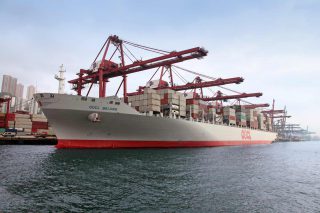OOIL Sees Red Ink amid Difficult Markets

Due to challenging market conditions, Hong Kong’s Orient Overseas International Limited (OOIL), owner of container transport businesses OOCL, suffered a full-year loss of USD 219.2 million in 2016, compared to a profit of USD 283.9 million seen a year earlier.
The company’s operating loss stood at USD 138.2 million, against an operating profit of USD 353.1 million posted in 2015.
“This past year has seen some of the most difficult markets in our industry’s history. A combination of steady but low growth in most regions and an overhang of excess supply built up in recent years led to extremely challenging conditions in many trade lanes for most of 2016,” Tung Chee Chen, Chairman of OOIL, commented.
“As fuel prices rose in the second half of the year, industry performance was badly affected by freight rates that frequently sank below the levels seen in 2009,” Tung noted.
Last year, the first phase of the company’s Middle Harbor Redevelopment Project in California was completed, with operations having commenced in April 2016. OOIL expects the second phase to be completed towards the end of this year.
During the year, the firm didn’t take delivery of any newbuildings nor did it place any orders for new vessels in 2016.
In 2016, four 13,200 TEU Mega Class vessels that had been chartered out to Japanese shipping company Nippon Yusen Kabushiki Kaisha (NYK Line) were returned to OOCL.
Tung said that OOCL continues to build its future on the “twin pillars of alliance membership.” The company has formed the Ocean Alliance with French CMA CGM, China’s COSCO and Taiwan’s Evergreen, which is scheduled to start operations in April 2017.
From May 2017, OOCL expects to begin taking delivery of its six 20,000 TEU newbuildings.
“Our 20,000 TEU class vessels enter service in 2017. Our investment in these vessels demonstrates our commitment to growing our business intelligently, and allows us to gain economies of scale in all our major East West trades. At the same time, we will maintain our focus on continuous cost improvement and further efficiency gains,” Tung pointed out.
In the outlook for 2017, Tung said that the industry supply and demand balance remains one of the largest risk factors. Expectations for net growth in 2017 suggest improvement in the situation, but time may be needed to absorb the existing supply overhang, according to Tung.
HEADLINES
- Do shipping markets want Biden or Trump for the win?
- All 18 crew safe after fire on Japanese-owned tanker off Singapore
- Singapore launching $44m co-investment initiative for maritime tech start-ups
- Cosco debuts Global Shipping Industry Chain Cooperation Initiative
- US warns of more shipping sanctions
- China continues seaport consolidation as Dalian offer goes unconditional